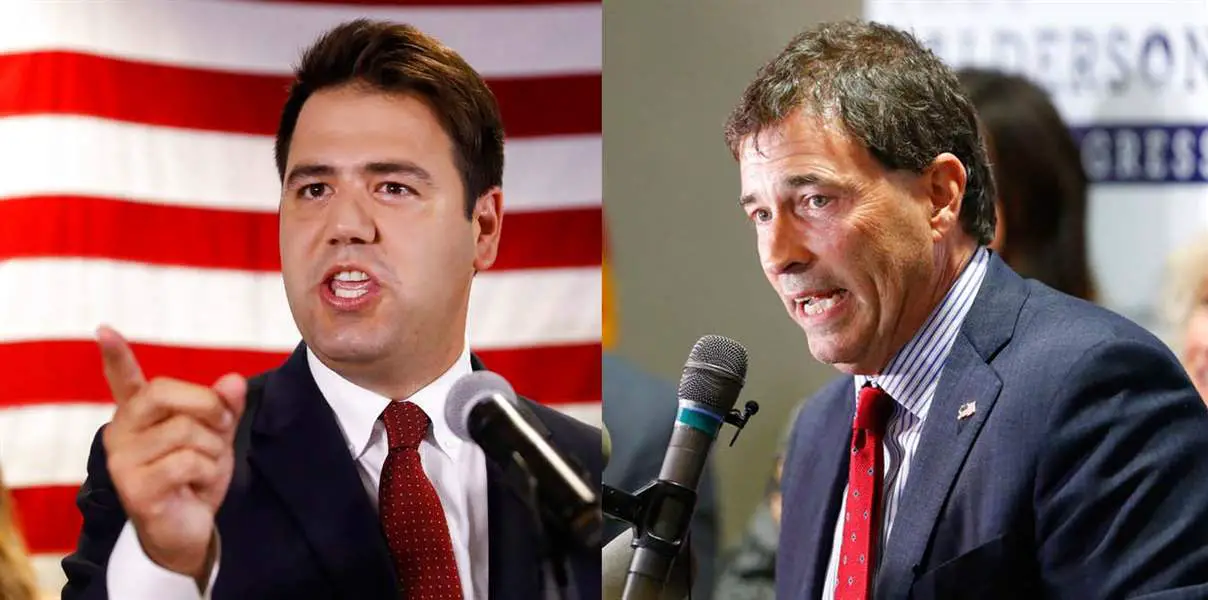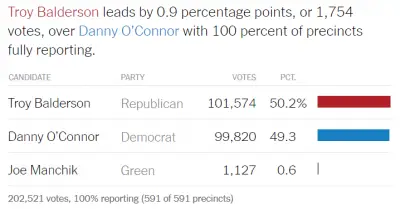It came down to the wire on Tuesday but Republicans likely managed to hold Ohio’s 12th Congressional District by less than one percent. Republican Troy Balderson, who received the endorsement of President Trump, is currently ahead of Democrat Danny O’Connor by a mere 0.9% of the vote with 100% of precincts reporting. Here are the full results from the New York Times:
Technically the results are not final yet as there are provisional ballots to count, according to CBS News:
The vote may come down to counting provisional and absentee ballots — but that could take days. County boards of elections reported that 3,435 provisional ballots were cast and there were 5,048 outstanding absentee ballots. State law dictates election officials cannot begin counting these ballots until the 11th day after the election, which would be Aug. 18.
The race has not yet been called, but Balderson, and President Trump, already claimed victory. What about a recount? We’re less than a one-percent difference. Vox explains the Ohio recount laws when it comes to races as tight as this:
In elections that cover multiple counties, like the Ohio 12th special, an automatic recount is triggered by the secretary of state when the vote differential is equal to or less than 0.5 percent. The secretary has to initiate a recount for statewide races — such as the governor’s contest — but the margin between the declared winner and loser is much slimmer: equal to less than 0.25 percent of the vote. (Any tie also triggers an automatic recount.)
But a losing candidate can also request a recount if the difference between votes isn’t small enough to set off an automatic recount. To do this, the presumed loser has to request a recount through a written application.
An automatic recount is likely out of the question, but it looks like O’Connor might be able to request one if there may be reason to believe it could alter the outcome. In most scenarios, recounts don’t yield differences in thousands of votes, sometimes maybe tens or hundreds. A recount would be a long shot for O’Connor and my gut says he’ll probably decide not to push the issue unless there are allegations of widespread voting irregularity. The results of the provisional ballots could change this scenario, but that remains to be seen.
So, how did Balderson pull it off and why did O’Connor seemingly come up short? Some of it simply has to do with Ohio-12 being a red-leaning district for three decades. Democrats rarely win there. The rest has to do with the campaign itself, and what drove Republican voters to the polls for Balderson.
Vox, once again, attempts to explain the playbook employed by Balderson:
And Republicans, who have been adamant that talking about a booming economy will save them in the 2018 midterms, seem to have abandoned touting their tax cuts altogether. Instead they’re turning to the Trump playbook: Don’t talk about the tax bill, and stoke the culture wars.
Over the weekend, President Donald Trump stumped for Balderson at a rally in the district, warning of a Democrat-run nation with “crime all over the place. You’re going to have people pouring across the border,” Trump said. Pro-Balderson ads have pivoted from the economy to attacking O’Connor as “Dishonest Danny” and “Dangerous Danny” — a Nancy Pelosi-loving liberal who will block Trump’s border wall.
Just months away from the 2018 midterm elections, the special election in Ohio’s 12th serves as another test of Republicans’ messaging strategy. It’s becoming increasingly clear that their one major legislative accomplishment of the year — tax cuts — doesn’t seem to be enough to win elections. And Tuesday might prove that a culture war against liberals might not be enough, either.
Culture wars versus economic messaging is the Vox read, and that may be a valid assessment. It would have been very easy for Republicans to get apathetic and stay home as is often the case for the party that last wins the White House. Something drove them to the polls enough to put Balderson over the top.
Former Ohio Governor, and frequent Trump critic, John Kasich, said that the President’s presence in the district and endorsement of Balderson actually hurt Republicans:
“It really doesn’t bode well for the Republican party because this shouldn’t even be contested,” Kasich said of the Ohio contest.
The governor said Balderson told him he didn’t ask Trump to come to Ohio to campaign for him. The president blasted Democrats during a raucous election rally for Balderson in the state on Saturday.
“I asked him, I said, ‘Troy, why did you invite Trump in here, the president?'” Kasich said. “He said, ‘No, I didn’t.’ So, you know, I think Donald Trump decides where he wants to go and I think they think they’re firing up the base, but I have to tell you, at the same time that he comes in here, I was with some women last night who said, ‘Hey, you know what, I’m not voting – and they’re Republicans – I’m not voting for the Republicans.'”
This is something that is hard to measure. Did Trump help or hurt Balderson? Would he have won by a higher margin if Trump didn’t show up? It’s possible that Trump’s involvement helped to motivate Democrats along with Republicans and the move could have easily backfired on the GOP. Kasich knows Ohio politics and the 12th district is not exactly Trump country being a fairly wealthy suburb of mostly college educated voters.
Either way, both parties are claiming a little bit of victory with Democrats touting the fact that they swung a red district ten points in their direction against Trump. That could mean closer Republican districts, say within four or five points, might be in real trouble if this trend holds nationwide. Republicans are touting that they held off the Democratic advancement by keeping another House seat safely in their column.
There were also some important primary races on Tuesday as well, you can get all the details on those from this CBS News story.
Donate Now to Support Election Central
- Help defend independent journalism
- Directly support this website and our efforts

